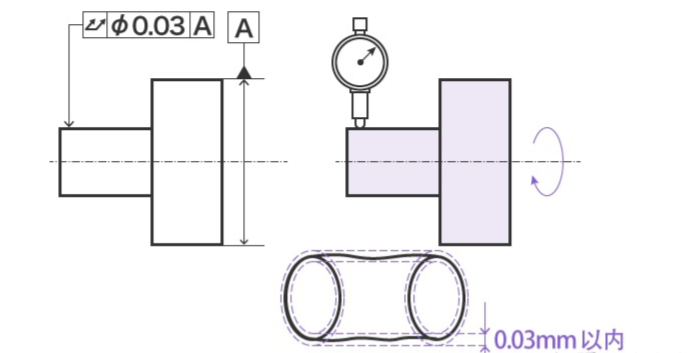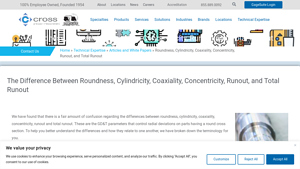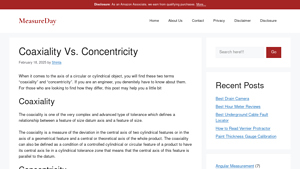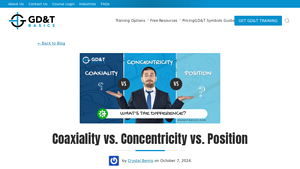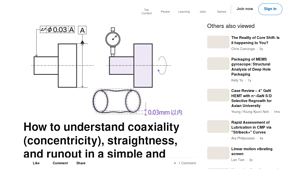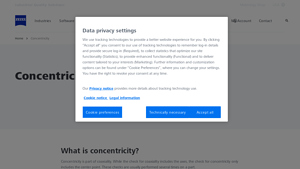Coaxiality Vs Concentricity Guide: Type, Cost, Top List…
Introduction: Navigating the Global Market for coaxiality vs concentricity
In a rapidly evolving global market, understanding the nuances of coaxiality versus concentricity has become critical for B2B buyers navigating complex engineering requirements. Sourcing precision components that meet exact tolerances can be fraught with challenges, particularly when the stakes involve high-performance applications across diverse industries. This guide delves into the fundamental differences between coaxiality and concentricity, two pivotal dimensions in geometric tolerancing that affect product performance, especially in sectors such as aerospace, automotive, and telecommunications.
Throughout this comprehensive resource, we explore the intricacies of coaxiality and concentricity, their specific applications, and the various tolerances that govern their use. Moreover, we provide actionable insights on how to effectively vet suppliers to ensure you secure components that align with your precise specifications. Buyers will also find guidance on cost implications and best practices for integrating tolerances into product design and manufacturing processes.
By equipping international B2B buyers, particularly in regions like Africa, South America, the Middle East, and Europe (with notable markets in Brazil and Germany), this guide empowers organizations to make informed purchasing decisions. Understanding these tolerances is not just about technical specifications—it’s about fostering reliability and performance in every component, ultimately leading to greater operational efficiency and market competitiveness.
Understanding coaxiality vs concentricity Types and Variations
| Type Name | Key Distinguishing Features | Primary B2B Applications | Brief Pros & Cons for Buyers |
|---|---|---|---|
| Coaxiality | Measures the alignment of axes between cylindrical features. | Automotive components, aerospace equipment | Pros: Ensures precise alignments; Cons: Complex measurement setup. |
| Concentricity | Focuses on the central points of circular parts being aligned. | High-speed rotating machinery, precision tools | Pros: Critical for balance and reduced vibrations; Cons: Higher cost precision process. |
| Cylindricity | Assesses how closely an object resembles a true cylinder in shape. | Manufacturing shafts, pins, and bolts | Pros: Guarantees performance; Cons: Requires strict quality checks. |
| Roundness | Evaluates how close a circular profile is to an ideal circle. | Piston rings, bores in engine blocks | Pros: Enhances smooth functionality; Cons: Less critical in non-rotating applications. |
| Runout | Measures the total variation of a part’s circular motion. | Disc brakes, rotating assemblies | Pros: Indicates overall part quality; Cons: Can be less specific than other tolerances. |
What are the Key Characteristics of Coaxiality in B2B Engineering?
Coaxiality is crucial in manufacturing and assembly processes that involve cylindrical parts, such as shafts and housings. It ensures that each cylindrical feature is positioned along the same axis, thus promoting smooth operational flow within mechanical systems. Successful coaxiality measurement often involves intricate setups and specialized tools, making it complex yet extremely valuable for applications in the automotive and aerospace sectors. Buyers must weigh the importance of precise alignment against the potential challenges of setup and measurement.
How Does Concentricity Contribute to Precision Engineering?
Concentricity is vital in industries where precision is non-negotiable, such as high-speed rotating machinery and precision tools. This tolerance guarantees that all relevant circles of a part share a common center, minimizing the risk of imbalance and improving overall performance. While concentricity checks can be meticulous and require advanced tools, they significantly reduce vibrations and enhance the durability of parts. Buyers should consider the necessity of such precision against the higher associated costs and complexities when sourcing components.
Why is Cylindricity Essential for High-Performance Manufacturing?
Understanding cylindricity is integral for B2B buyers involved in the production of components like shafts and pins that require a standardized cylindrical shape. It assesses both roundness and straightness, ensuring parts can fit and function optimally within larger assemblies. Cylindricity measurements can be stringent, with limited tolerances that ensure high performance. Companies must prioritize the need for such characteristics when determining supplier capabilities, while also being prepared for potentially rigorous quality control processes.
What Role Does Roundness Play in the Functionality of Circular Components?
Roundness is a critical metric for components that require smooth operational characteristics, such as piston rings and bore sections in engines. It measures how closely a circular cross-section resembles a perfect circle, affecting friction and wear rates during operation. For buyers, ensuring exact roundness can lead to enhanced efficiency and performance longevity in mechanical systems. However, the necessity for exact measurements should match the operational demands of their applications, as overly stringent measures can lead to unnecessary costs.
How Does Runout Provide Insight into Component Quality?
Runout gives an overall assessment of a part’s circular motion by measuring the total variation during rotation, proving essential for applications like disc brakes and other rotating assemblies. This measurement indicates how well a part maintains its intended function and quality. While a broader indicator than others, it does not specify the nature of the deviations, making it less precise compared to coaxiality or concentricity. Buyers should take into account the importance of this metric in their quality assessments while balancing it against the context-specific needs of their applications.
Key Industrial Applications of coaxiality vs concentricity
| Industry/Sector | Specific Application of coaxiality vs concentricity | Value/Benefit for the Business | Key Sourcing Considerations for this Application |
|---|---|---|---|
| Aerospace and Defense | Precision alignment of aircraft components | Enhanced safety and reliability in flight operations | Certifications (ISO, AS9100), testing facilities, lead times |
| Automotive | Manufacturing of drivetrain components | Improved performance and fuel efficiency | Tolerance levels, material specifications, supplier reliability |
| Wholesale & Retail | Production of rotating equipment like motors and pumps | Minimized wear and longer lifespan of components | Cost efficiency, production capacity, delivery times |
| Medical Devices | Creation of surgical instruments and implants | Greater precision, increased patient safety | Compliance with medical standards (ISO 13485), traceability |
| Renewable Energy | Fabrication of components in wind turbines | Increased operational efficiency and reliability | Material quality, local sourcing, environmental impact |
How is Coaxiality vs. Concentricity Used in Aerospace and Defense?
In the aerospace sector, coaxiality is critical for ensuring that components like engine mounts and fuselage parts align perfectly. This alignment significantly reduces the risk of vibrations, which can impact flight safety. International buyers must prioritize suppliers with AS9100 certification and the capability to conduct rigorous testing to meet these high standards. Proper coaxiality reduces maintenance costs and enhances overall aircraft reliability, which is crucial for passenger trust and operational efficacy.
Why is Coaxiality Important in Automotive Manufacturing?
In automotive manufacturing, coaxiality and concentricity are vital in producing drivetrain components such as flywheels and crankshafts. Precise manufacturing ensures optimal performance and reduced fuel consumption, greatly enhancing a vehicle’s efficiency. B2B buyers should consider tolerance levels and material specifications meticulously while ensuring suppliers are capable of maintaining the required consistency across production. Supplier reliability is also critical to avoid production delays and ensure timely delivery of high-quality parts.
How Do Coaxiality and Concentricity Influence Wholesale & Retail Production?
In the wholesale and retail sectors, particularly for equipment like motors and pumps, both coaxiality and concentricity play significant roles in minimizing component wear. Proper alignment contributes to the smoother operation of rotating equipment, which is essential for maintaining high operational standards in retail settings. Buyers should focus on cost efficiency and production capacity when sourcing these components, with an emphasis on lead times that meet supply chain demands.
What Role Do Coaxiality and Concentricity Play in Medical Devices?
In medical device manufacturing, maintaining precise coaxiality and concentricity is essential for surgical instruments and implants to function correctly. Such precision ensures that devices perform reliably, increasing the safety and health outcomes for patients. International buyers in this sector must prioritize suppliers that comply with ISO 13485 standards and can provide thorough traceability of their materials and processes, ensuring that all products are safe and effective.
How Does Coaxiality vs. Concentricity Impact Renewable Energy Solutions?
In renewable energy, particularly in the fabrication of wind turbines, the coefficients of coaxiality and concentricity are critical for operational efficiency. Proper alignment of turbine components ensures optimal performance, reducing downtime and maintenance requirements. Sourcing considerations in this area must include material quality and local sourcing options to minimize environmental impact, given the global focus on sustainability.
3 Common User Pain Points for ‘coaxiality vs concentricity’ & Their Solutions
Scenario 1: Understanding Tolerance Requirements for Precision Manufacturing
The Problem: In many industries, such as automotive and aerospace, the precise alignment of components is critical. A buyer may struggle to differentiate between coaxiality and concentricity, leading to incorrect specifications for parts. This confusion can result in production delays, increased costs, and potential product failures due to misaligned components, ultimately affecting customer satisfaction and brand reputation.
The Solution: To tackle this challenge, buyers should start by clarifying the tolerance requirements for their specific application. They should consult detailed engineering documentation or work closely with their design engineers. Creating a clear specification that distinguishes between coaxiality and concentricity is vital. When drafting engineering drawings, use precise GD&T symbols to indicate whether the part should adhere to coaxiality or concentricity tolerances. For added clarity, incorporate notes that explain the implications of these tolerances on part function. Beside engineering specs, provide context on why one tolerance is preferred over the other for the application at hand, ensuring all team members understand the requirements comprehensively.
Scenario 2: Encountering Measurement Challenges in Quality Control
The Problem: A B2B buyer might face difficulties in measuring coaxiality and concentricity during the quality control process. Inconsistent measurement techniques or inadequate tools can yield unreliable results, leading to disputes with suppliers about part quality. This not only hampers quality assurance but can also delay production if parts do not meet required specifications.
The Solution: To overcome measurement challenges, buyers should invest in high-quality measurement tools suitable for precision tolerancing, such as laser measurement systems or coordinate measuring machines (CMMs) that can assess both coaxiality and concentricity effectively. Additionally, establishing a clear standard operating procedure (SOP) for measurements can enhance consistency. Training staff on the proper use of these measurement tools and emphasizing the importance of accurate readings will help minimize errors. Buyers should also consider third-party inspections from accredited measurement labs when necessary to ensure objectivity in quality assessments. By implementing such measures, they can confidently identify non-conforming parts early in the process, reducing production delays and maintaining high quality.
Scenario 3: Managing Supplier Communication and Expectations
The Problem: Buyers often encounter issues with suppliers who do not fully understand the specific requirements for coaxiality and concentricity, leading to miscommunications and mismatches in product delivery. This gap in understanding can create frustration on both sides and disrupt the supply chain, affecting project timelines and financial outcomes.
The Solution: To bridge this communication gap, buyers should develop a formal communication protocol with suppliers. This includes providing thorough documentation that details the tolerances required for coaxiality and concentricity for each component. Conducting joint review sessions can be beneficial, where both parties discuss requirements and expected tolerances collaboratively. Using visual aids, such as diagrams and reference samples, can help suppliers better grasp the specific needs. Buyers should also participate in supplier quality audits to ensure that evaluation criteria for coaxiality and concentricity are understood and followed properly. By fostering a strong relationship built on clear expectations and ongoing communication, buyers can enhance collaboration, leading to a more streamlined production process and higher-quality end products.
By proactively addressing these pain points with actionable strategies, B2B buyers can navigate the complexities of coaxiality and concentricity, ensuring higher precision in their manufacturing processes and maintaining robust relationships with suppliers.
Strategic Material Selection Guide for coaxiality vs concentricity
How Do Common Materials Affect Coaxiality vs. Concentricity?
Understanding material properties is critical when selecting components that require precise coaxiality and concentricity. Here, we explore four common materials—steel, aluminum, plastic, and composites—focusing on their performance characteristics, advantages, and limitations that impact B2B applications, particularly in diverse global markets.
Steel: A Benchmark Material
Steel remains a preferred choice for applications requiring coaxiality and concentricity due to its high strength and rigidity. It boasts excellent temperature and pressure ratings, making it suitable for high-stress environments such as aerospace and automotive components.
Pros & Cons: Steel’s durability ensures longevity, while its relatively low cost makes it an economical option. However, manufacturing complexities can arise due to the need for precise machining, particularly when achieving tight tolerances necessary for concentricity. Furthermore, steel’s susceptibility to corrosion necessitates protective coatings, which can increase costs.
Application Impact: Steel is ideal for high-temperature applications and can accommodate a variety of media, including liquids and gases, given its strength and corrosion resistance. Nonetheless, buyers must consider compliance with international standards such as ASTM and DIN, particularly in regions like Europe, where stringent regulations exist.
Aluminum: Lightweight and Versatile
Aluminum stands out for its lightweight and corrosion-resistant properties. Many B2B applications benefit from aluminum’s ability to maintain structural integrity while minimizing weight, essential in industries such as aerospace and automotive.
Pros & Cons: Its manufacturing process is generally less complex compared to steel, facilitating mass production. However, aluminum may not withstand as high temperatures and pressures as steel, which can limit its applications in high-stress environments. Additionally, it is typically more expensive than steel.
Application Impact: Comparatively, aluminum suits various corrosive environments but is not always compatible with all media, particularly when fatigue strength and thermal expansion are concerns. Buyers in Africa and South America may find aluminum a robust choice for maritime applications, given its resistance to saltwater.
Plastic: Cost-Effective and Lightweight
Plastics have gained traction in applications demanding good coaxiality and concentricity, particularly where corrosion and weight are significant factors. Specialty plastics, such as PEEK or Nylon, can handle moderate temperatures and pressures.
Pros & Cons: Plastics are relatively inexpensive and can be molded into complex shapes easily, thus lowering manufacturing complexity. However, they tend to have lower strength and durability compared to metals, which may limit their application scope. Plastic is often unsuitable for high-temperature environments.
Application Impact: Although plastic can resist certain chemicals, it may not be compatible with harsh media or extreme conditions. International buyers should consider common standards with materials like ASTM or ISO certification to ensure compatibility.
Composites: Performance-Driven Solution
Composite materials, consisting of multiple substances, offer enhanced performance characteristics, such as increased strength-to-weight ratios and improved thermal stability.
Pros & Cons: Composites can maintain coaxiality and concentricity effectively under various conditions, but their manufacturing process is usually more complex and costly. Additionally, they may exhibit significant variation in properties depending on the type of fibers used and the matrix material.
Application Impact: Useful in industries like aerospace and medical devices, composites can handle severe conditions; however, they must meet rigorous international compliance standards. Buyers in Europe and the Middle East might prefer composites for high-performance applications, provided they are mindful of the higher cost implications.
Material Comparison Summary Table
| Material | Typical Use Case for coaxiality vs concentricity | Key Advantage | Key Disadvantage/Limitation | Relative Cost (Low/Med/High) |
|---|---|---|---|---|
| Steel | Aerospace and automotive components requiring high strength | High durability and heat resistance | Complexity in machining; corrosion risks | Low |
| Aluminum | Lightweight structural components in automotive and aerospace | Lightweight and corrosion-resistant | Lower temperature tolerance; higher cost | Med |
| Plastic | Low-load applications requiring corrosion resistance | Cost-effective and easy to mold | Lower strength and temperature limits | Low |
| Composites | High-performance parts in aerospace and medical devices | Superior strength-to-weight ratio | Complex manufacturing; high cost | High |
This detailed analysis of chosen materials provides B2B buyers with critical insights into selecting the right material in alignment with their coaxiality and concentricity requirements, enhancing end-product reliability and performance.
In-depth Look: Manufacturing Processes and Quality Assurance for coaxiality vs concentricity
What Are the Key Manufacturing Processes for Coaxiality and Concentricity?
In manufacturing, achieving high levels of coaxiality and concentricity is critical for creating precision components used in various industries, such as aerospace, automotive, and medical devices. Here, we outline the main stages of the manufacturing process and the techniques employed to ensure quality results.
How Does Material Preparation Influence Coaxiality and Concentricity?
Material preparation is the foundation for achieving desired tolerances in coaxiality and concentricity. This phase typically involves selecting the right materials, which could range from metals to polymers, based on application requirements. Common processes include:
-
Material Selection and Sourcing: Buyers should ensure that materials meet industry standards like ASTM or ISO certifications. Choose materials that allow for minimal deformation during subsequent processing.
-
Pre-Cutting and Shaping: Using techniques like laser cutting or waterjet cutting can provide the precision needed for initial shaping. This is particularly important for cylindrical components where any angular discrepancy will affect final coaxiality and concentricity.
-
Casting or Forging: Processes such as die casting or hot forging can be employed, notably for mass-producing cylindrical shapes. Ensuring uniform material properties during these stages is pivotal for dimensional stability during transformation.
Which Forming Techniques Are Essential for Maintaining Precise Tolerances?
Once the materials are prepared, the next stage is forming, where the primary shapes are realized. Techniques to consider include:
-
Turning and Milling: CNC turning and milling are commonly used for machining cylindrical parts. Here, precise control of tool movement is vital to maintain the coaxial alignment and concentricity of turned components.
-
Electroforming and Electroplating: These methods can achieve significant surface finishes that help maintain geometric tolerances. This is particularly useful for high-precision applications like medical instruments.
-
Tube Bending and Expansion: For tubular components, ensuring coaxiality during bending is essential. Specific fixtures and jigs can keep the dies aligned and ensure the tubes maintain a consistent diameter along their lengths.
How Does Assembly Impact the Accuracy of Coaxiality and Concentricity?
In the assembly stage, components must be fitted together without introducing any misalignment that can compromise coaxiality or concentricity:
-
Precision Assembly Fixtures: Utilizing dedicated fixtures that hold components in the correct alignment can minimize errors during the assembly. This is especially vital in sectors like automotive, where multiple cylindrical parts must interact seamlessly.
-
Adjustable Mounting Techniques: Incorporating adjustable mounts during assembly allows slight modifications to ensure that axes are properly aligned, achieving the required coaxiality and concentricity without manual force.
What Finishing Processes Enhance Measurement Reliability?
Finishing processes play a crucial role in developing the final properties of coaxial and concentric parts:
-
Grinding and Honing: These processes enhance surface finishes while achieving final diameters. Precision grinding can be particularly effective in achieving high tolerances required for concentric parts.
-
Surface Treatment: Techniques like anodizing or plating can enhance wear resistance and maintain surface geometry, which is particularly important for parts that will undergo dynamic loading.
-
Inspection and Measurement: Quality checks through advanced metrology equipment (like CMMs – Coordinate Measuring Machines) help ensure that the part’s final dimensions comply with both coaxiality and concentricity specifications.
What International Standards Govern Quality Assurance for Coaxiality and Concentricity?
Manufacturers serving global markets must adhere to international standards to ensure consistent quality. ISO 9001 provides a quality management system framework adaptable to different sectors. Additionally:
- ISO 2768 covers general tolerances for linear dimensions and angular tolerances in engineering drawings, ensuring clarity in specifications.
- Industry-specific standards such as API (American Petroleum Institute) offer guidelines particularly important in sectors such as oil and gas.
How Are Quality Control Checkpoints Structured?
Quality Control (QC) checkpoints should be integrated throughout the manufacturing process to guarantee compliance with specified tolerances:
-
Incoming Quality Control (IQC): Inspection of raw materials to ensure they meet required standards is essential to avoid downstream issues.
-
In-Process Quality Control (IPQC): Monitoring processes in real time allows for the immediate identification and rectification of deviations in coaxiality or concentricity.
-
Final Quality Control (FQC): At this stage, comprehensive inspections, including geometrical measurements and functional testing, confirm that components meet defined specifications before final shipment.
What Testing Methods Validate Coaxiality and Concentricity?
Employing various techniques gives assurance that components will perform as intended:
-
Coordinate Measuring Machines (CMM): These machines provide high-precision measurements of geometry, invaluable for verifying both coaxiality and concentricity.
-
Laser Scanning: Advanced laser scanning techniques can measure surface profiles to assess deviations from ideal geometries, crucial for high-speed rotating components.
-
Runout Testing: For components that will be in motion, conducting runout tests helps determine how well parts align while they are operational.
How Can B2B Buyers Verify Supplier Quality Control?
For B2B buyers, especially those operating on an international scale, verifying the quality control measures of suppliers is crucial to mitigate risks:
-
Supplier Audits: Conducting regular audits of suppliers’ facilities ensures that they adhere to quality management systems and are compliant with international standards.
-
Reviewing Quality Reports: Suppliers should provide detailed reports of their QC processes, inspection results, and any corrective actions taken to display transparency.
-
Third-Party Inspection Services: Engaging reputable third-party inspectors can add an extra assurance layer and foster trust between buyers and suppliers, especially in new markets.
What Are the Quality Control Nuances for International Buyers?
Understanding regional variations is critical for B2B buyers, particularly from diverse geographical areas such as Africa, South America, the Middle East, and Europe:
- Regulatory Compliance: For example, CE marking is essential in the European market, denoting compliance with EU safety and environmental requirements.
- Language Barriers: Specific QC documentation should be available in the languages relevant to the local market to minimize misunderstandings.
- Cultural Differences in Assurance Practices: Buyers should be aware of cultural variations in business practices that could affect communication and quality perceptions.
By understanding manufacturing processes, quality assurance measures, and testing methodologies concerning coaxiality and concentricity, B2B buyers can make informed decisions when selecting suppliers and mitigate risks in their purchasing strategies.
Practical Sourcing Guide: A Step-by-Step Checklist for ‘coaxiality vs concentricity’
Introduction
This sourcing guide aims to equip B2B buyers with a clear, actionable checklist for procuring components or services related to coaxiality and concentricity. Understanding the distinctions and measurement protocols for these technical specifications is crucial in maintaining quality standards, particularly for industries that demand high precision.
Step 1: Define Your Technical Specifications
Establishing clear technical specifications is critical for ensuring you procure the right components. Start by determining the tolerances and precision requirements for your application. This will help you articulate your needs to potential suppliers, ensuring they can provide products that meet your exact criteria.
- Consider the application: Identify whether coaxiality, concentricity, or both are necessary based on your engineering requirements.
- Document all specifications: Create a detailed list of dimensions, tolerances, and other relevant parameters to share with suppliers.
Step 2: Research Potential Suppliers
Thoroughly researching potential suppliers is key to ensuring reliability and quality. Look for suppliers with a proven track record in your industry, focusing on those that specialize in precision measurement and manufacturing.
- Investigate industry presence: Assess their experience in coaxiality and concentricity tolerances.
- Check customer testimonials: Read reviews and case studies to gauge previous client satisfaction and performance history.
Step 3: Verify Supplier Certifications
Ensuring the supplier’s credentials is vital for maintaining quality control. Look for certifications, such as ISO 9001, which indicate adherence to international standards in quality management systems.
- Request documentation: Ask for relevant certification papers to confirm compliance with industry standards.
- Evaluate calibration procedures: Inquire about their measurement equipment calibration methods to ensure accuracy over time.
Step 4: Request Sample Products or Prototypes
Before making a large purchase, requesting samples or prototypes aids in validating a supplier’s capacity to meet your specifications. This step can identify any discrepancies in quality and lead to informed decision-making.
- Assess material quality: Evaluate the samples for integrity, dimensions, and adherence to specification tolerances.
- Conduct comparisons: Test samples against your defined criteria and check whether they meet your coaxiality and concentricity requirements.
Step 5: Establish Quality Control Procedures
Quality control must be an integral part of your procurement process. Design a rigorous inspection protocol that checks for coaxiality and concentricity in the received products.
- Define inspection criteria: Establish clear standards for acceptance or rejection based on your technical specifications.
- Utilize measurement tools: Consider procurement of inspection equipment or leverage third-party services to validate the received products.
Step 6: Negotiate Terms and Secure Logistics
Negotiation is essential for ensuring favorable terms, including pricing, delivery times, and after-sales support. While price is important, remember to balance it with quality assurance and supplier reliability.
- Clarify roles: Specify who will be responsible for transportation costs, insurance, and any potential tariffs, especially for international shipments.
- Discuss lead times: Ensure that delivery schedules align with your project timelines to avoid unnecessary delays.
Step 7: Monitor Supplier Performance
Once a supplier is engaged, ongoing assessment of their performance is crucial. Establish metrics to evaluate the consistency and reliability of the products they deliver.
- Create feedback loops: Regularly communicate with your supplier about product quality and delivery timeliness to address any concerns proactively.
- Document issues: Keep records of any discrepancies for future reference, which can help with renegotiation or transitioning to other suppliers if necessary.
This practical guide provides key insight into the procurement process for coaxiality and concentricity, ensuring that you make informed decisions and secure quality products for your business needs.
Comprehensive Cost and Pricing Analysis for coaxiality vs concentricity Sourcing
In the B2B landscape, the cost and pricing analysis for coaxiality versus concentricity sourcing presents an essential consideration for international buyers. Each aspect of this sourcing process can significantly influence margins, total cost of ownership, and ultimately, competitive positioning in various markets.
What Are the Key Cost Components in Coaxiality and Concentricity Sourcing?
Understanding the cost components is crucial for any business looking to navigate the complexities of sourcing precision tolerances like coaxiality and concentricity. Here are the primary elements:
-
Materials: The type of material used for manufacturing the cylindrical features has a direct impact on costs. High-grade materials that ensure precision may increase costs. For both coaxiality and concentricity, materials commonly used include metals like aluminum and steel, with specifics dictated by the desired mechanical properties.
-
Labor: The complexity of achieving the required tolerances necessitates skilled labor. The higher the precision, the more experienced the workforce required, which can drive up labor costs. International buyers should consider labor cost variations in different regions.
-
Manufacturing Overhead: This encompasses the indirect costs related to production, such as utilities, equipment depreciation, and factory maintenance. Regions with higher industrial costs will naturally have higher overheads.
-
Tooling: Specialized tooling is often required for machining coaxial or concentric features. The initial investment in high-quality tooling can be significant, and buyers should factor these costs into their pricing negotiations.
-
Quality Control (QC): Given the precision required, QC is an important part of the sourcing cycle. Testing for coaxiality and concentricity metrics involves sophisticated measuring equipment, which can bolster costs. It’s crucial for buyers to ensure suppliers have robust QC measures in place.
-
Logistics: Transportation and handling costs also vary, particularly for international shipments. Incoterms will define responsibilities and risks, impacting the overall logistic costs associated with sourcing.
-
Margin: Suppliers will always include a profit margin, influenced by the complexity, volume, and market demand for coaxiality and concentricity components. Understanding typical industry margins can aid buyers in negotiations.
How Do Price Influencers Affect Sourcing Decisions?
There are several variables that can influence the pricing of coaxiality and concentricity parts:
-
Volume/MOQ (Minimum Order Quantity): Larger orders often lead to reduced per-unit costs due to economies of scale. Buyers should inquire about volume discounts and plan orders accordingly.
-
Specifications and Customization: Custom modifications to standard parts can lead to additional costs. It’s essential for buyers to clearly define specifications to avoid unexpected pricing.
-
Material Selection: Higher quality materials not only increase the initial sourcing cost but can also affect longevity and operational costs in the long run. Buyers must weigh initial expenses against potential future savings.
-
Quality Certifications: Certifications like ISO or industry-specific standards can add cost but also guarantee a level of quality and reliability, especially important for industries like aerospace or medical.
-
Supplier Factors: Supplier reputation, location, and production capabilities can all affect pricing. Engaging with multiple suppliers to compare costs and offerings can provide significant leverage in negotiations.
-
Incoterms: The choice of Incoterms will define shipping responsibilities and risk, impacting cost outcomes. Buyers must navigate these terms wisely to align with their operational capabilities.
What Buyer Tips Can Enhance Cost Efficiency in Sourcing?
Successful B2B sourcing hinges on effective negotiation strategies and awareness of total cost implications:
-
Negotiation: Always approach negotiations armed with knowledge of market rates, production costs, and competitive pricing. Establishing a collaborative relationship with suppliers can yield better terms.
-
Total Cost of Ownership (TCO): Assess not just the purchase price, but the long-term implications of sourcing decisions. Consider factors like maintenance, durability, and logistics to obtain a comprehensive view.
-
Pricing Nuances for International Buyers: Different regions exhibit varying market conditions. For example, additional import duties or taxes in Africa and South America can significantly impact total costs. Regional dynamics should inform pricing strategies and supplier selections.
Disclaimer on Indicative Prices
Prices in this market can fluctuate based on economic conditions, supplier capabilities, and material availability. As such, it’s advisable for buyers to request customized quotes tailored to their specific requirements, rather than relying on standardized pricing.
Careful consideration of these factors will lead to more transparent cost structures and pricing strategies, ultimately benefiting buyers in the highly competitive markets of coaxiality and concentricity sourcing.
Alternatives Analysis: Comparing coaxiality vs concentricity With Other Solutions
When exploring tolerancing in precision engineering, coaxiality and concentricity are two important methods for ensuring the alignment of cylindrical components. However, there are alternative solutions that can also achieve desired outcomes in terms of alignment and geometric control. This section delves into comparisons of coaxiality and concentricity against two viable alternative solutions: runout and alignment fixtures.
| Comparison Aspect | Coaxiality Vs Concentricity | Runout | Alignment Fixtures |
|---|---|---|---|
| Performance | High precision measurement of axis alignment. | Effective for controlling deviations in round components during rotation. | Ensures accurate positioning in assembly processes. |
| Cost | Can be costly due to precision requirements. | Generally lower cost as it evaluates surface variations directly. | Requires upfront investment but can save costs in assembly processes. |
| Ease of Implementation | Complex, often requiring specialized equipment and expertise. | Easier to implement, typically using standard measuring techniques. | Requires skilled operators but can simplify repetitive alignment tasks. |
| Maintenance | Low maintenance, but high calibrations needed for accuracy. | Low maintenance, straightforward measurement checks. | Regular checks necessary to maintain alignment accuracy. |
| Best Use Case | Applications requiring high levels of precision, like aerospace and automotive. | Ideal for components with dynamic motion and high rotational speeds. | Suitable for assembly lines and processes needing quick fixtures for repeated tasks. |
How Does Runout Compare to Coaxiality and Concentricity?
Runout measures the total deviation from a specified axis along a rotating axis. This method is particularly advantageous when evaluating the performance of rotating parts, as it accounts for both radial and axial deviations. While it is simpler to implement compared to coaxiality and concentricity, it may not provide the same level of precision for stationary components. Nevertheless, runout is a cost-effective method typically used in industries that require efficiency over ultra-high precision.
What About Alignment Fixtures as an Alternative?
Alignment fixtures play a crucial role in ensuring components are correctly positioned during assembly processes. These tools can offer a more cost-effective solution, particularly in high-volume production scenarios where repeated accuracy is essential. While setup may require skilled personnel, the savings in time and reduction in human error can lead to increased productivity and lower overall operational costs.
How Can B2B Buyers Choose the Right Solution?
B2B buyers should evaluate their specific application needs when deciding between coaxiality, concentricity, and alternatives like runout and alignment fixtures. High-precision industries, such as aerospace and automotive, may require the foundational assurance that coaxiality and concentricity provide. For applications where cost savings and speed are paramount, especially in production lines, runout and alignment fixtures emerge as valuable alternatives. Ultimately, the choice depends on the balance between precision requirements, budget constraints, and operational workflows unique to each buyer’s processes.
Essential Technical Properties and Trade Terminology for coaxiality vs concentricity
What are the Critical Technical Specifications for Coaxiality and Concentricity?
1. Tolerance Levels
Tolerance refers to the permissible variation in a dimension and is crucial in both coaxiality and concentricity. For coaxiality, the tolerance determines how far off the axis of one cylindrical feature can be from another. A tighter tolerance level means higher precision, which is essential in high-performance industries like aerospace and automotive. In contrast, concentricity focuses on ensuring that multiple circular features share the same center. Understanding and specifying the appropriate tolerance level is fundamental for ensuring product quality and competitiveness in the market.
2. Material Grade
The material grade of components directly affects their strength, flexibility, and thermal properties. Specific material grades may be required to meet the demands of coaxial and concentric designs in high-stress applications. For instance, aerospace components often utilize high-strength alloys or composites that can tolerate specific tolerances while minimizing weight. Selecting the right material grade influences not only performance but also the durability of components over time.
3. Geometric Dimensioning and Tolerancing (GD&T) Compliance
GD&T is a system used to define and communicate engineering tolerances. Coaxiality and concentricity are elements within this framework that enable engineers to specify and quantify acceptable deviations. Compliance with GD&T standards not only ensures that parts fit together properly but also reduces the risks associated with misalignment, which can lead to failure. For global suppliers, understanding GD&T is vital for maintaining quality assurance across diverse manufacturing processes.
4. Relevant Measurement Techniques
Precision measurement techniques (e.g., coordinate measuring machines (CMM), laser scanning) must align with the requirements of coaxiality and concentricity. The choice of measurement method affects inspection accuracy and, ultimately, product reliability. Being well-versed in these techniques can guide B2B buyers in verifying the quality of components before acceptance, thus minimizing the risk of defects impacting functionality.
5. Runout and Total Runout Parameters
Runout measurements indicate how much a part deviates from perfect rotation. Coaxiality, measured in three dimensions, relates closely to total runout, which accounts for both radial and axial variations. These parameters are critical for applications involving rotating components, where even minor deviations can lead to significant operational issues. B2B buyers must consider these parameters to gauge component performance, particularly in manufacturing where precision is non-negotiable.
What Common Jargon Should B2B Buyers Understand?
1. OEM (Original Equipment Manufacturer)
An OEM is a company that produces parts or equipment that may be marketed by another manufacturer. In the context of coaxiality and concentricity, understanding OEM specifications ensures that parts meet the required tolerances and quality levels. This is essential for building trust with suppliers who provide critical components for finished products.
2. MOQ (Minimum Order Quantity)
MOQ refers to the smallest quantity of a product that a supplier is willing to sell. For precise components needing specific tolerances, the MOQ can represent a significant investment. Understanding MOQs helps B2B buyers plan their purchases effectively while considering inventory management.
3. RFQ (Request for Quote)
An RFQ is a document issued by a buyer inviting suppliers to submit proposals and pricing for specific products. When drafting an RFQ for components requiring coaxiality or concentricity, precision in specifying tolerances and material requirements is vital to receive accurate quotes.
4. Incoterms (International Commercial Terms)
Incoterms define the responsibilities of buyers and sellers regarding shipping, insurance, and tariffs. Familiarity with these terms ensures that B2B clients from different regions grasp how costs associated with coaxial or concentric components will be managed throughout the supply chain, critical for budget forecasting and compliance.
Summary
In conclusion, understanding the technical specifications and trade terminology surrounding coaxiality and concentricity is vital for B2B buyers engaging with modern manufacturing. Grasping these concepts can enhance collaboration with suppliers, ensuring both parties align with product performance requirements and quality standards.
Navigating Market Dynamics and Sourcing Trends in the coaxiality vs concentricity Sector
Market Overview & Key Trends
The global market for coaxiality and concentricity measurement is driven by increasing demands for precision in sectors such as aerospace, automotive, and medical devices. Technological advancements in precision measurement tools have facilitated the evolution of sophisticated testing methods that enhance the accuracy of these tolerances. As industries lean towards automation and integrated digital solutions, International B2B buyers should explore platforms that offer advanced metrology technologies, including laser scanning and optical measurement systems.
Key trends include the adoption of Industry 4.0 principles, which promote interconnected machinery for real-time data capture, enabling better quality control and efficiency. For regions such as Africa and South America, there is a surge in local manufacturing efforts, driving demand for reliable measurement solutions that ensure product quality. Conversely, in Europe, stringent regulations regarding product specifications and tolerances are propelling the need for more precise measurement capabilities, thus influencing procurement strategies.
Another emerging trend is the increased use of software solutions for data analysis and quality assurance, which allow companies to maintain compliance with international standards for concentricity and coaxiality. B2B buyers must prioritize sourcing from suppliers who offer not only equipment but also integrated solutions capable of maximizing operational efficiency and ensuring products meet rigorous international specifications.
Sustainability & Ethical Sourcing in B2B
As the manufacturing landscape shifts towards sustainability, B2B buyers in the coaxiality and concentricity sectors are increasingly prioritizing environmentally responsible sourcing practices. The environmental impact of manufacturing processes and their waste management is now more critical than ever. Buyers should consider suppliers who adopt circular economy principles, reducing waste and improving resource efficiency throughout their operations.
Ethical sourcing is also becoming a cornerstone of business strategy, as customers and regulatory bodies demand transparency in supply chains. Manufacturers who utilize “green” certifications, such as ISO 14001 for environmental management or certifications for sustainably sourced materials, are gaining a competitive edge in the market. For sectors that demand high-precision components, sourcing from suppliers committed to environmental stewardship not only aligns with corporate responsibility but also enhances brand reputation.
Furthermore, buyers should seek suppliers that implement sustainable practices in their measurement processes. This could include reducing energy consumption in testing environments or utilizing eco-friendly materials in their measuring instruments. As sustainability becomes a key differentiator, Buyers must integrate environmental criteria into their purchasing decisions to support long-term goals.
Brief Evolution/History
The concepts surrounding coaxiality and concentricity have evolved significantly since their inception in engineering and manufacturing. Initially, rudimentary measurement systems relied on mechanical devices. However, as manufacturing processes became more complex, the necessity for precision drove the development of comprehensive measurement standards, such as Geometric Dimensioning and Tolerancing (GD&T).
In the late 20th century, technological advancements in measurement tools marked a major shift. The introduction of digital measurement systems enhanced the accuracy and efficiency of evaluating coaxiality and concentricity. As industries grew to recognize the crucial role of these parameters in product performance, the push for advanced metrology solutions became imperative. Today, businesses are not only concerned about compliance with international standards but also focused on integrating innovative technologies that deliver continuous improvements in manufacturing precision. This evolution reflects a broader trend within B2B markets towards higher quality and precision-driven operational benchmarks.
Frequently Asked Questions (FAQs) for B2B Buyers of coaxiality vs concentricity
-
How do I determine whether to use coaxiality or concentricity for my product?
Selecting between coaxiality and concentricity primarily depends on your product’s functional requirements. Coaxiality confirms the alignment of two or more axes, ensuring that features are uniformly positioned along the same axial path, which is crucial in rotating applications. In contrast, concentricity focuses on the positional relationship of the mean points of circular features around a common axis, making it vital for high-precision applications. Assess your specific tolerance requirements, performance expectations, and manufacturing capabilities to determine the best option. -
What is the best approach for measuring coaxiality and concentricity?
For precise measurement, utilize specialized tools such as coordinate measuring machines (CMMs) with appropriate probes. For coaxiality, ensure you are measuring along the axes of the cylindrical features and confirm their alignment within specified tolerances. Concentricity is measured by checking the midpoints of circular features using appropriate gauges. It is advisable to utilize standard measurement practices in compliance with ISO or ASME guidelines to ensure accuracy and reliability in your results. -
How do I vet suppliers for coaxiality and concentricity components?
Begin by assessing the supplier’s experience and expertise in precision engineering and GD&T (Geometric Dimensioning and Tolerancing). Review sample work, certifications, and client testimonials to confirm their capabilities with coaxiality and concentricity tolerances. Additionally, request detailed information on their quality assurance processes and measuring equipment. Establishing clear communication regarding your specific requirements will help gauge their technical competence and reliability as a supplier. -
What customization options should I expect for coaxiality and concentricity parts?
Many manufacturers offer customization options based on your requirements, including size, material, and specific tolerance ranges. Communicate your precise needs for coaxiality and concentricity, including any unique design modifications or geometric constraints. Discussing these aspects early in the ordering process can help suppliers provide necessary recommendations and adjust their manufacturing processes to meet your specifications reliably. -
What are common minimum order quantities (MOQs) for coaxiality and concentricity products?
MOQs can vary significantly depending on the supplier and the complexity of the components required. Typically, suppliers may set MOQs based on production costs, material usage, and operational efficiency. For precision parts, you may find that MOQs can start at 50-100 units; however, it is best to discuss your project needs with suppliers to negotiate favorable terms that can work for both parties. -
What payment terms are standard for international purchases of precision parts?
Payment terms can vary significantly by supplier and region. Common practices include upfront payment for smaller orders or net 30/60/90 days for established buyers with longer-term relationships. It’s essential to clarify terms such as deposits and payment methods available (e.g., bank transfers, credit cards) before finalizing the order. To mitigate risk, consider using trade finance options or letters of credit for larger international purchases. -
What quality assurance measures should I request to guarantee precision in coaxiality and concentricity?
Prioritize suppliers who adhere to quality management systems like ISO 9001 to ensure consistent production quality. Request detailed reports on their inspection processes, including documentation of measurement data and adherence to GD&T standards. Inquire about their calibration standards for measurement equipment and whether they conduct third-party validation. This transparency will help ensure that the components meet your precision requirements. -
How can I optimize logistics for international sourcing of coaxiality and concentricity components?
Efficient logistics starts with selecting suppliers who have experience managing international shipments and customs regulations. Coordinate with the supplier about packaging and shipping options that minimize damage during transit. Utilize reliable freight forwarders familiar with the destination country’s import regulations to avoid delays. Additionally, consider logistics costs in your total budget to set realistic expectations on delivery timelines and incorporate buffer zones for potential customs clearance issues.
Important Disclaimer & Terms of Use
⚠️ Important Disclaimer
The information provided in this guide, including content regarding manufacturers, technical specifications, and market analysis, is for informational and educational purposes only. It does not constitute professional procurement advice, financial advice, or legal advice.
While we have made every effort to ensure the accuracy and timeliness of the information, we are not responsible for any errors, omissions, or outdated information. Market conditions, company details, and technical standards are subject to change.
B2B buyers must conduct their own independent and thorough due diligence before making any purchasing decisions. This includes contacting suppliers directly, verifying certifications, requesting samples, and seeking professional consultation. The risk of relying on any information in this guide is borne solely by the reader.
Top 6 Coaxiality Vs Concentricity Manufacturers & Suppliers List
1. CrossCo – Precision GD&T Solutions
Domain: crossco.com
Registered: 1997 (28 years)
Introduction: Roundness, Cylindricity, Coaxiality, Concentricity, Runout, and Total Runout are GD&T parameters that control radial deviations on parts having a round cross section. Roundness, or circularity, is a 2D tolerance related to the perfection of a cylinder, sphere, or cone’s cross-section being close to a circle. It can be affected by deviations such as a flat spot on a cylinder or lobing due to grindi…
2. MeasureDay – Advanced Tolerance Solutions
Domain: measureday.com
Registered: 2023 (2 years)
Introduction: Coaxiality and concentricity are advanced tolerances used in engineering to measure the relationship between cylindrical features and a theoretical axis. Coaxiality defines the deviation in the central axis of two cylindrical features, requiring the central axis to lie within a specific cylindrical tolerance zone in relation to a datum. It is indicated through a combination of symbols as it lacks …
3. GD&T Basics – Coaxiality vs. Concentricity
Domain: gdandtbasics.com
Registered: 2014 (11 years)
Introduction: The text discusses the difference between coaxiality, concentricity, and position as defined by the ISO 1101 standard. It explains that concentricity is treated as a subcategory of position and that a specific symbol controls both coaxiality and concentricity, with the ACS (All Cross Sections) symbol needed to interpret it as concentricity. The document highlights that the ASME Y14.5 interpretatio…
4. Precision Mechanical Components – Key Product Details
Domain: linkedin.com
Registered: 2002 (23 years)
Introduction: The article discusses the following key product details related to precision mechanical components: 1. **Concentricity**: Indicates the degree of co-axiality of the measured axis to a reference axis with a tolerance of 0.08 mm between the cylinders. 2. **Straightness**: Reflects the degree of straightness of elements with a tolerance of 0.1 mm between parallel lines or a cylindrical surface with a…
5. Eng-Tips – GD&T Insights
Domain: eng-tips.com
Registered: 1997 (28 years)
Introduction: This company, Eng-Tips – GD&T Insights, is a notable entity in the market. For specific product details, it is recommended to visit their website directly.
6. Zeiss – Concentricity Measurement Solutions
Domain: zeiss.com
Registered: 1995 (30 years)
Introduction: Concentricity is a measurement that assesses the location of one or more independent circles around a datum element, which can be either an axis or a center point. It involves the establishment of a planar or circular tolerance zone around the datum, allowing for permissible deviations of the center point. An example provided describes a washer with an outer diameter of 15 mm and an inner bore hol…
Strategic Sourcing Conclusion and Outlook for coaxiality vs concentricity
As businesses navigate the complexities of precision manufacturing, understanding the nuances between coaxiality and concentricity emerges as a critical competitive advantage. Both tolerances play pivotal roles in ensuring optimal performance and reliability across various applications, particularly within sectors such as aerospace, automotive, and healthcare. By prioritizing strategic sourcing of components that meet these precise specifications, international buyers can mitigate risks associated with dimensional deviations, thereby enhancing overall product quality.
Investing in quality measurement and inspection practices will not only assure that components conform to necessary tolerances but will also foster long-term partnerships with manufacturers committed to excellence. Given the diverse market conditions in regions such as Africa, South America, the Middle East, and Europe, bidders should remain proactive in sourcing versatile solutions that cater specifically to their operational needs.
Looking ahead, as technological advancements continue to reshape the manufacturing landscape, the demand for precisely coaxial or concentric components will increase. B2B buyers must leverage this understanding to drive future procurement strategies. Consider reevaluating your supply chain relationships today to ensure that you are equipped with the most advanced and reliable components in your production processes, ultimately driving your business toward sustained growth and success.

